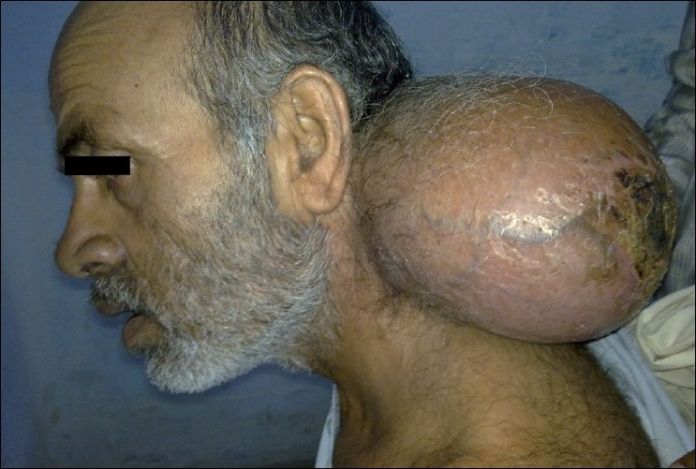- Giant lipomas are benign soft tissue tumours rarely found on the posterior part of the neck. They are defined as lesions that measure at least 10 cm in one dimension or weighing a minimum of 1,000 g.
- A bleeding pressure ulcer on a giant tumour is also a rare presentation.
- Surgical intervention of the tumour can be challenging if it extends to the spinal cord. It may cause malignant change, especially if it occurs in old age.
A 68-year-old male patient presented to the surgical outpatient department with an 11-year history of a huge lump on his neck. Moreover, an ulcer was present on top of the lump for the last 9 months. The ulcer also had episodic bleedings for the last 6 months. This case study describes a rare case of a giant lipoma with a bleeding decubitus ulcer (pressure ulcer).
On examination, the lump on the neck was nontender and soft to firm consistency. It measured 22 cm x 12 cm and was located on the posterior side of the neck. The tumour was nontender, soft and firm in consistency with a decubitus ulcer at the top of the lump measuring 6 cm x 5.5 cm.
Dilated veins were present in the skin around the decubitus ulcer. There was no regional lymphadenopathy. Fine needle aspiration cytology revealed mature lipocytes which is an indication of a lipomatous lesion. A Contrast Enhanced Computed Tomography Scan was performed which showed a giant subcutaneous lipoma at the posterior triangle with no septations. The lipoma had no communication with the spinal cord.
The lipoma was separated from the surrounding tissue under general anaesthesia with sharp and blunt dissections. The resected mass weighed 2.2 kg and measured 22 cm x 12 cm in diameter. He had an uneventful postoperative period. The patient was discharged 9 days after the procedure.
Histopathological analysis of the resected mass showed mature, proliferative lipocytes and no cellular atypia. The findings were consistent with the diagnosis of a benign giant lipoma.
References
Giant Lipoma of Posterior Neck with Bleeding Decubitus Ulcer: A Rare Entity https://www.ncbi.nlm.nih.gov/pmc/articles/PMC2956954/




